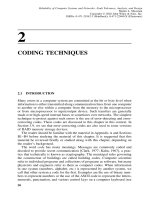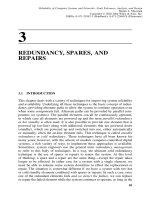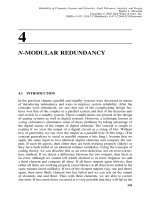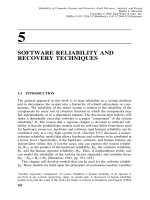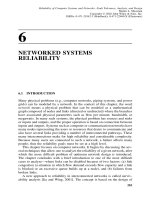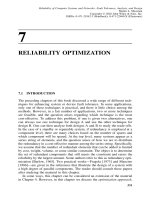Độ tin cậy của hệ thống máy tính và mạng P1
Bạn đang xem bản rút gọn của tài liệu. Xem và tải ngay bản đầy đủ của tài liệu tại đây (175.71 KB, 29 trang )
1
INTRODUCTION
Reliability of Computer Systems and Networks: Fault Tolerance, Analysis, and Design
Martin L. Shooman
Copyright
2002
John Wiley & Sons, Inc.
ISBNs:
0
-
471
-
29342
-
3
(Hardback);
0
-
471
-
22460
-X (Electronic)
1
The central theme of this book is the use of reliability and availability com-
putations as a means of comparing fault-tolerant designs. This chapter defines
fault-tolerant computer systems and illustrates the prime importance of such
techniques in improving the reliability and availability of digital systems that
are ubiquitous in the
21
st century. The main impetus for complex, digital sys-
tems is the microelectronics revolution, which provides engineers and scien-
tists with inexpensive and powerful microprocessors, memories, storage sys-
tems, and communication links. Many complex digital systems serve us in
areas requiring high reliability, availability, and safety, such as control of air
traffic, aircraft, nuclear reactors, and space systems. However, it is likely that
planners of financial transaction systems, telephone and other communication
systems, computer networks, the Internet, military systems, office and home
computers, and even home appliances would argue that fault tolerance is nec-
essary in their systems as well. The concluding section of this chapter explains
how the chapters and appendices of this book interrelate.
1
.
1
WHAT IS FAULT-TOLERANT COMPUTING?
Literally, fault-tolerant computing means computing correctly despite the exis-
tence of errors in a system. Basically, any system containing redundant com-
ponents or functions has some of the properties of fault tolerance. A desktop
computer and a notebook computer loaded with the same software and with
files stored on floppy disks or other media is an example of a redundant sys-
2
INTRODUCTION
tem. Since either computer can be used, the pair is tolerant of most hardware
and some software failures.
The sophistication and power of modern digital systems gives rise to a host
of possible sophisticated approaches to fault tolerance, some of which are as
effective as they are complex. Some of these techniques have their origin in
the analog system technology of the
1940
s–
1960
s; however, digital technology
generally allows the implementation of the techniques to be faster, better, and
cheaper. Siewiorek [
1992
] cites four other reasons for an increasing need for
fault tolerance: harsher environments, novice users, increasing repair costs, and
larger systems. One might also point out that the ubiquitous computer system
is at present so taken for granted that operators often have few clues on how
to cope if the system should go down.
Many books cover the architecture of fault tolerance (the way a fault-tolerant
system is organized). However, there is a need to cover the techniques required
to analyze the reliability and availability of fault-tolerant systems. A proper
comparison of fault-tolerant designs requires a trade-off among cost, weight,
volume, reliability, and availability. The mathematical underpinnings of these
analyses are probability theory, reliability theory, component failure rates, and
component failure density functions.
The obvious technique for adding redundancy to a system is to provide a
duplicate (backup) system that can assume processing if the operating (on-line)
system fails. If the two systems operate continuously (sometimes called hot
redundancy), then either system can fail first. However, if the backup system
is powered down (sometimes called cold redundancy or standby redundancy),
it cannot fail until the on-line system fails and it is powered up and takes over.
A standby system is more reliable (i.e., it has a smaller probability of failure);
however, it is more complex because it is harder to deal with synchronization
and switching transients. Sometimes the standby element does have a small
probability of failure even when it is not powered up. One can further enhance
the reliability of a duplicate system by providing repair for the failed system.
The average time to repair is much shorter than the average time to failure.
Thus, the system will only go down in the rare case where the first system fails
and the backup system, when placed in operation, experiences a short time to
failure before an unusually long repair on the first system is completed.
Failure detection is often a difficult task; however, a simple scheme called
a voting system is frequently used to simplify such detection. If three systems
operate in parallel, the outputs can be compared by a voter, a digital comparator
whose output agrees with the majority output. Such a system succeeds if all
three systems or two or the three systems work properly. A voting system can
be made even more reliable if repair is added for a failed system once a single
failure occurs.
Modern computer systems often evolve into networks because of the flexible
way computer and data storage resources can be shared among many users.
Most networks either are built or evolve into topologies with multiple paths
between nodes; the Internet is the largest and most complex model we all use.
WHAT IS FAULT-TOLERANT COMPUTING?
3
If a network link fails and breaks a path, the message can be routed via one or
more alternate paths maintaining a connection. Thus, the redundancy involves
alternate paths in the network.
In both of the above cases, the redundancy penalty is the presence of extra
systems with their concomitant cost, weight, and volume. When the trans-
mission of signals is involved in a communications system, in a network, or
between sections within a computer, another redundancy scheme is sometimes
used. The technique is not to use duplicate equipment but increased transmis-
sion time to achieve redundancy. To guard against undetected, corrupting trans-
mission noise, a signal can be transmitted two or three times. With two trans-
missions the bits can be compared, and a disagreement represents a detected
error. If there are three transmissions, we can essentially vote with the majority,
thus detecting and correcting an error. Such techniques are called error-detect-
ing and error-correcting codes, but they decrease the transmission speed by
a factor of two or three. More efficient schemes are available that add extra
bits to each transmission for error detection or correction and also increase
transmission reliability with a much smaller speed-reduction penalty.
The above schemes apply to digital hardware; however, many of the relia-
bility problems in modern systems involve software errors. Modeling the num-
ber of software errors and the frequency with which they cause system failures
requires approaches that differ from hardware reliability. Thus, software reli-
ability theory must be developed to compute the probability that a software
error might cause system failure. Software is made more reliable by testing to
find and remove errors, thereby lowering the error probability. In some cases,
one can develop two or more independent software programs that accomplish
the same goal in different ways and can be used as redundant programs. The
meaning of independent software, how it is achieved, and how partial software
dependencies reduce the effects of redundancy are studied in Chapter
5
, which
discusses software.
Fault-tolerant design involves more than just reliable hardware and software.
System design is also involved, as evidenced by the following personal exam-
ples. Before a departing flight I wished to change the date of my return, but the
reservation computer was down. The agent knew that my new return flight was
seldom crowded, so she wrote down the relevant information and promised to
enter the change when the computer system was restored. I was advised to con-
firm the change with the airline upon arrival, which I did. Was such a procedure
part of the system requirements? If not, it certainly should have been.
Compare the above example with a recent experience in trying to purchase
tickets by phone for a concert in Philadelphia
16
days in advance. On my
Monday call I was told that the computer was down that day and that nothing
could be done. On my Tuesday and Wednesday calls I was told that the com-
puter was still down for an upgrade, and so it took a week for me to receive
a call back with an offer of tickets. How difficult would it have been to print
out from memory files seating plans that showed seats left for the next week
so that tickets could be sold from the seating plans? Many problems can be
4
INTRODUCTION
avoided at little cost if careful plans are made in advance. The planners must
always think “what do we do if . . .?” rather than “it will never happen.”
This discussion has focused on system reliability: the probability that the
system never fails in some time interval. For many systems, it is acceptable
for them to go down for short periods if it happens infrequently. In such cases,
the system availability is computed for those involving repair. A system is said
to be highly available if there is a low probability that a system will be down
at any instant of time. Although reliability is the more stringent measure, both
reliability and availability play important roles in the evaluation of systems.
1
.
2
THE RISE OF MICROELECTRONICS AND THE COMPUTER
1
.
2
.
1
A Technology Timeline
The rapid rise in the complexity of tasks, hardware, and software is why fault
tolerance is now so important in many areas of design. The rise in complexity
has been fueled by the tremendous advances in electrical and computer tech-
nology over the last
100
–
125
years. The low cost, small size, and low power
consumption of microelectronics and especially digital electronics allow prac-
tical systems of tremendous sophistication but with concomitant hardware and
software complexity. Similarly, the progress in storage systems and computer
networks has led to the rapid growth of networks and systems.
A timeline of the progress in electronics is shown in Shooman [
1990
, Table
K-
1
]. The starting point is the
1874
discovery that the contact between a metal
wire and the mineral galena was a rectifier. Progress continued with the vacuum
diode and triode in
1904
and
1905
. Electronics developed for almost a half-cen-
tury based on the vacuum tube and included AM radio, transatlantic radiotele-
phony, FM radio, television, and radar. The field began to change rapidly after
the discovery of the point contact and field effect transistor in
1947
and
1949
and, ten years later in
1959
, the integrated circuit.
The rise of the computer occurred over a time span similar to that of micro-
electronics, but the more significant events occurred in the latter half of the
20
th century. One can begin with the invention of the punched card tabulating
machine in
1889
. The first analog computer, the mechanical differential ana-
lyzer, was completed in
1931
at MIT, and analog computation was enhanced by
the invention of the operational amplifier in
1938
. The first digital computers
were electromechanical; included are the Bell Labs’ relay computer (
1937
–
40
),
the Z
1
, Z
2
, and Z
3
computers in Germany (
1938
–
41
), and the Mark I com-
pleted at Harvard with IBM support (
1937
–
44
). The ENIAC developed at the
University of Pennsylvania between
1942
and
1945
with U.S. Army support
is generally recognized as the first electronic computer; it used vacuum tubes.
Major theoretical developments were the general mathematical model of com-
putation by Alan Turing in
1936
and the stored program concept of computing
published by John von Neuman in
1946
. The next hardware innovations were
in the storage field: the magnetic-core memory in
1950
and the disk drive
THE RISE OF MICROELECTRONICS AND THE COMPUTER
5
in
1956
. Electronic integrated circuit memory came later in
1975
. Software
improved greatly with the development of high-level languages: FORTRAN
(
1954
–
58
), ALGOL (
1955
–
56
), COBOL (
1959
–
60
), PASCAL (
1971
), the C
language (
1973
), and the Ada language (
1975
–
80
). For computer advances
related to cryptography, see problem
1
.
25
.
The earliest major computer systems were the U.S. Airforce SAGE air
defense system (
1955
), the American Airlines SABER reservations system
(
1957
–
64
), the first time-sharing systems at Dartmouth using the BASIC lan-
guage (
1966
) and the MULTICS system at MIT written in the PL-I language
(
1965
–
70
), and the first computer network, the ARPA net, that began in
1969
.
The concept of RAID fault-tolerant memory storage systems was first pub-
lished in
1988
. The major developments in operating system software were
the UNIX operating system (
1969
–
70
), the CM operating system for the
8086
Microprocessor (
1980
), and the MS-DOS operating system (
1981
). The choice
of MS-DOS to be the operating system for IBM’s PC, and Bill Gates’ fledgling
company as the developer, led to the rapid development of Microsoft.
The first home computer design was the Mark-
8
(Intel
8008
Microproces-
sor), published in Radio-Electronics magazine in
1974
, followed by the Altair
personal computer kit in
1975
. Many of the giants of the personal computing
field began their careers as teenagers by building Altair kits and programming
them. The company then called Micro Soft was founded in
1975
when Gates
wrote a BASIC interpreter for the Altair computer. Early commercial personal
computers such as the Apple II, the Commodore PET, and the Radio Shack
TRS-
80
, all marketed in
1977
, were soon eclipsed by the IBM PC in
1981
.
Early widely distributed PC software began to appear in
1978
with the Word-
star word processing system, the VisiCalc spreadsheet program in
1979
, early
versions of the Windows operating system in
1985
, and the first version of the
Office business software in
1989
. For more details on the historical develop-
ment of microelectronics and computers in the
20
th century, see the following
sources: Ditlea [
1984
], Randall [
1975
], Sammet [
1969
], and Shooman [
1983
].
Also see www.intel.com and www.microsoft.com.
This historical development leads us to the conclusion that today one can
build a very powerful computer for a few hundred dollars with a handful of
memory chips, a microprocessor, a power supply, and the appropriate input,
output, and storage devices. The accelerating pace of development is breath-
taking, and of course all the computer memory will be filled with software
that is also increasing in size and complexity. The rapid development of the
microprocessor—in many ways the heart of modern computer progress—is
outlined in the next section.
1
.
2
.
2
Moore’s Law of Microprocessor Growth
The growth of microelectronics is generally identified with the growth of
the microprocessor, which is frequently described as “Moore’s Law” [Mann,
2000
]. In
1965
, Electronics magazine asked Gordon Moore, research director
6
INTRODUCTION
TABLE
1
.
1
Complexity of Microchips and Moore’s Law
Microchip Complexity: Moore’s Law
Year Transistors
Complexity: Transistors
1959 1 2
0
1
1964 32 2
5
32
1965 64 2
6
64
1975 64
,
000 2
16
65
,
536
of Fairchild Semiconductor, to predict the future of the microchip industry.
From the chronology in Table
1
.
1
, we see that the first microchip was invented
in
1959
. Thus the complexity was then one transistor. In
1964
, complexity had
grown to
32
transistors, and in
1965
, a chip in the Fairchild R&D lab had
64
transistors. Moore projected that chip complexity was doubling every year,
based on the data for
1959
,
1964
, and
1965
. By
1975
, the complexity had
increased by a factor of
1
,
000
; from Table
1
.
1
, we see that Moore’s Law was
right on track. In
1975
, Moore predicted that the complexity would continue to
increase at a slightly slower rate by doubling every two years. (Some people
say that Moore’s Law complexity predicts a doubling every
18
months.)
In Table
1
.
2
, the transistor complexity of Intel’s CPUs is compared with
TABLE
1
.
2
Transistor Complexity of Microprocessors and Moore’s Law
Assuming a Doubling Period of Two Years
Microchip
Complexity
Moore’s Law Complexity:
Year CPU Transistors
Transistors
1971
.
50 4004 2
,
300
(
2
0
) ×
2
,
300
2
,
300
1978
.
75 8086 31
,
000
(
2
7
.
25
/
2
) ×
2
,
300
28
,
377
1982
.
75 80286 110
,
000
(
2
4
/
2
) ×
28
,
377
113
,
507
1985
.
25 80386 280
,
000
(
2
2
.
5
/
2
) ×
113
,
507
269
,
967
1989
.
75 80486 1
,
200
,
000
(
2
4
.
5
/
2
) ×
269
,
967
1
,
284
,
185
1993
.
25
Pentium (P
5
)
3
,
100
,
000
(
2
3
.
5
/
2
) ×
1
,
284
,
185
4
,
319
,
466
1995
.
25
Pentium Pro
5
,
500
,
000
(
2
2
/
2
) ×
4
,
319
,
466
8
,
638
,
933
(P
6
)
1997
.
50
Pentium II
7
,
500
,
000
(
2
2
.
25
/
2
) ×
8
,
638
,
933
18
,
841
,
647
(P
6
+ MMX)
1998
.
50
Merced (P
7
)
14
,
000
,
000
(
2
3
.
25
/
2
) ×
8
,
638
,
933
26
,
646
,
112
1999
.
75
Pentium III
28
,
000
,
000
(
2
1
.
25
/
2
) ×
26
,
646
,
112
41
,
093
,
922
2000
.
75
Pentium
442
,
000
,
000
(
2
1
/
2
) ×
41
,
093
,
922
58
,
115
,
582
Note: This table is based on Intel’s data from its Microprocessor Report: http:
//
www.physics.udel.
edu
/
wwwusers.watson.scen
103
/
intel.html.
THE RISE OF MICROELECTRONICS AND THE COMPUTER
7
Moore’s Law, with a doubling every two years. Note that there are many
closely spaced releases with different processor speeds; however, the table
records the first release of the architecture, generally at the initial speed.
The Pentium P
5
is generally called Pentium I, and the Pentium II is a P
6
with MMX technology. In
1993
, with the introduction of the Pentium, the
Intel microprocessor complexities fell slightly behind Moore’s Law. Some
say that Moore’s Law no longer holds because transistor spacing cannot be
reduced rapidly with present technologies [Mann,
2000
; Markov,
1999
]; how-
ever, Moore, now Chairman Emeritus of Intel Corporation, sees no funda-
mental barriers to increased growth until
2012
and also sees that the physical
limitations on fabrication technology will not be reached until
2017
[Moore,
2000
].
The data in Table
1
.
2
is plotted in Fig.
1
.
1
and shows a close fit to Moore’s
Law. The three data points between
1997
and
2000
seem to be below the curve;
however, the Pentium
4
data point is back on the Moore’s Law line. Moore’s
Law fits the data so well in the first
15
years (Table
1
.
1
) that Moore has occu-
pied a position of authority and respect at Fairchild and, later, Intel. Thus,
there is some possibility that Moore’s Law is a self-fulfilling prophecy: that
is, the engineers at Intel plan their new projects to conform to Moore’s Law.
The problems presented at the end of this chapter explore how Moore’s Law
is faring in the
21
st century.
An article by Professor Seth Lloyd of MIT in the September
2000
issue
of Nature explores the fundamental limitations of Moore’s Law for a laptop
based on the following: Einstein’s Special Theory of Relativity (E
mc
2
),
Heisenberg’s Uncertainty Principle, maximum entropy, and the Schwarzschild
Radius for a black hole. For a laptop with one kilogram of mass and one liter
of volume, the maximum available power is
25
million megawatt hours (the
energy produced by all the world’s nuclear power plants in
72
hours); the ulti-
mate speed is
5
.
4
×
10
50
hertz (about
10
43
the speed of the Pentium
4
); and
the memory size would be
2
.
1
×
10
31
bits, which is
4
×
10
30
bytes (
1
.
6
×
10
22
times that for a
256
megabyte memory) [Johnson,
2000
]. Clearly, fabri-
cation techniques will limit the complexity increases before these fundamental
limitations.
1
.
2
.
3
Memory Growth
Memory size has also increased rapidly since
1965
, when the PDP-
8
mini-
computer came with
4
kilobytes of core memory and when an
8
kilobyte sys-
tem was considered large. In
1981
, the IBM personal computer was limited
to
640
,
000
kilobytes of memory by the operating system’s nearsighted spec-
ifications, even though many “workaround” solutions were common. By the
early
1990
s,
4
or
8
megabyte memories for PCs were the rule, and in
2000
,
the standard PC memory size has grown to
64
–
128
megabytes. Disk memory
has also increased rapidly: from small
32
–
128
kilobyte disks for the PDP
8
e
8
INTRODUCTION
1970 1975 1980 1985 1990 1995 2000 2005
1,000
10,000
100,000
1,000,000
10,000,000
100,000,000
Moore’s Law
(2-Year Doubling Time)
Year
Number of Transistors
Figure
1
.
1
Comparison of Moore’s Law with Intel data.
computer in
1970
to a
10
megabyte disk for the IBM XT personal computer
in
1982
. From
1991
to
1997
, disk storage capacity increased by about
60
%
per year, yielding an eighteenfold increase in capacity [Fisher,
1997
; Markoff,
1999
]. In
2001
, the standard desk PC came with a
40
gigabyte hard drive.
If Moore’s Law predicts a doubling of microprocessor complexity every two
years, disk storage capacity has increased by
2
.
56
times each two years, faster
than Moore’s Law.
THE RISE OF MICROELECTRONICS AND THE COMPUTER
9
1
.
2
.
4
Digital Electronics in Unexpected Places
The examples of the need for fault tolerance discussed previously focused on
military, space, and other large projects. There is no less a need for fault toler-
ance in the home now that electronics and most electrical devices are digital,
which has greatly increased their complexity. In the
1940
s and
1950
s, the most
complex devices in the home were the superheterodyne radio receiver with
5
vacuum tubes, and early black-and-white television receivers with
35
vacuum
tubes. Today, the microprocessor is ubiquitous, and, since a large percentage of
modern households have a home computer, this is only the tip of the iceberg.
In
1997
, the sale of embedded microcomponents (simpler devices than those
used in computers) totaled
4
.
6
billion, compared with about
100
million micro-
processors used in computers. Thus computer microprocessors only represent
2
% of the market [Hafner,
1999
; Pollack,
1999
].
The bewildering array of home products with microprocessors includes
the following: clothes washers and dryers; toasters and microwave ovens;
electronic organizers; digital televisions and digital audio recorders; home
alarm systems and elderly medic alert systems; irrigation systems; pacemak-
ers; video games; Web-surfing devices; copying machines; calculators; tooth-
brushes; musical greeting cards; pet identification tags; and toys. Of course
this list does not even include the cellular phone, which may soon assume
the functions of both a personal digital assistant and a portable Internet inter-
face. It has been estimated that the typical American home in
1999
had
40
–
60
microprocessors—a number that could grow to
280
by
2004
. In addition, a
modern family sedan contains about
20
microprocessors, while a luxury car
may have
40
–
60
microprocessors, which in some designs are connected via a
local area network [Stepler,
1998
; Hafner,
1999
].
Not all these devices are that simple either. An electronic toothbrush has
3
,
000
lines of code. The Furby, a $
30
electronic–robotic pet, has
2
main pro-
cessors,
21
,
600
lines of code, an infrared transmitter and receiver for Furby-
to-Furby communication, a sound sensor, a tilt sensor, and touch sensors on
the front, back, and tongue. In short supply before Christmas
1998
, Web site
prices rose as high as $
147
.
95
plus shipping! [USA Today,
1998
]. In
2000
, the
sensation was Billy Bass, a fish mounted on a wall plaque that wiggled, talked,
and sang when you walked by, triggering an infrared sensor.
Hackers have even taken an interest in Furby and Billy Bass. They have
modified the hardware and software controlling the interface so that one Furby
controls others. They have modified Billy Bass to speak the hackers’ dialog
and sing their songs.
Late in
2000
, Sony introduced a second-generation dog-like robot called
Aibo (Japanese for “pal”); with
20
motors, a
32
-bit RISC processor,
32
megabytes of memory, and an artificial intelligence program. Aibo acts like
a frisky puppy. It has color-camera eyes and stereo-microphone ears, touch
sensors, a sound-synthesis voice, and gyroscopes for balance. Four different
“personality” modules make this $
1
,
500
robot more than a toy [Pogue,
2001
].
10
INTRODUCTION
What is the need for fault tolerance in such devices? If a Furby fails, you
discard it, but it would be disappointing if that were the only sensible choice
for a microwave oven or a washing machine. It seems that many such devices
are designed without thought of recovery or fault-tolerance. Lawn irrigation
timers, VCRs, microwave ovens, and digital phone answering machines are all
upset by power outages, and only the best designs have effective battery back-
ups. My digital answering machine was designed with an effective recovery
mode. The battery backup works well, but it “locks up” and will not function
about once a year. To recover, the battery and AC power are disconnected for
about
5
minutes; when the power is restored, a
1
.
5
-minute countdown begins,
during which the device reinitializes. There are many stories in which failure
of an ignition control computer stranded an auto in a remote location at night.
Couldn’t engineers develop a recovery mode to limp home, even if it did use a
little more gas or emit fumes on the way home? Sufficient fault-tolerant tech-
nology exists; however, designers have to use it. Fortunately, the cellular phone
allows one to call for help!
Although the preceding examples relate to electronic systems, there is no
less a need for fault tolerance in mechanical, pneumatic, hydraulic, and other
systems. In fact, almost all of us need a fault-tolerant emergency procedure to
heat our homes in case of prolonged power outages.
1
.
3
RELIABILITY AND AVAILABILITY
1
.
3
.
1
Reliability Is Often an Afterthought
The attainment of high reliability and availability is very difficult to achieve in
very complex systems. Thus, a system designer should formulate a number of
different approaches to a problem and weigh the pluses and minuses of each
design before recommending an approach. One should be careful to base con-
clusions on an analysis of facts, not on conjecture. Sometimes the best solution
includes simplifying the design a bit by leaving out some marginal, complex
features. It may be difficult to convince the authors of the requirements that
sometimes “less is more,” but this is sometimes the best approach. Design deci-
sions often change as new technology is introduced. At one time any attempt to
digitize the Library of Congress would have been judged infeasible because of
the storage requirement. However, by using modern technology, this could be
accomplished with two modern RAID disk storage systems such as the EMC
Symmetrix systems, which store more than nine terabytes (
9
×
10
12
bytes)
[EMC Products-At-A-Glance, www.emc.com]. The computation is outlined in
the problems at the end of this chapter.
Reliability and availability of the system should always be two factors that
are included, along with cost, performance, time of development, risk of fail-
ure, and other factors. Sometimes it will be necessary to discard a few design
objectives to achieve a good design. The system engineer should always keep
RELIABILITY AND AVAILABILITY
11
in mind that the design objectives generally contain a list of key features and a
list of desirable features. The design must satisfy the key features, but if one or
two of the desirable features must be eliminated to achieve a superior design,
the trade-off is generally a good one.
1
.
3
.
2
Concepts of Reliability
Formal definitions of reliability and availability appear in Appendices A and
B; however, the basic ideas are easy to convey without a mathematical devel-
opment, which will occur later. Both of these measures apply to how good the
system is and how frequently it goes down. An easy way to introduce reliabil-
ity is in terms of test data. If
50
systems operate for
1
,
000
hours on test and
two fail, then we would say the probability of failure, P
f
, for this system in
1
,
000
hours of operation is
2
/
50
or P
f
(
1
,
000
)
0
.
04
. Clearly the probability
of success, P
s
, which is known as the reliability, R, is given by R(
1
,
000
)
P
s
(
1
,
000
)
1
− P
f
(
1
,
000
)
48
/
50
0
.
96
. Thus, reliability is the probability
of no failure within a given operating period. One can also deal with a fail-
ure rate, fr, for the same system that, in the simplest case, would be fr
2
failures
/
(
50
×
1
,
000
) operating hours—that is, fr
4
×
10
−
5
or, as it is some-
times stated, fr
z
40
failures per million operating hours, where z is often
called the hazard function. The units used in the telecommunications industry
are fits (failures in time), which are failures per billion operating hours. More
detailed mathematical development relates the reliability, the failure rate, and
time. For the simplest case where the failure rate z is a constant (one gener-
ally uses l to represent a constant failure rate), the reliability function can be
shown to be R(t)
e
−lt
. If we substitute the preceding values, we obtain
R(
1
,
000
)
e
−
4
×
10
−
5
×
1
,
000
0
.
96
which agrees with the previous computation.
It is now easy to show that complexity causes serious reliability problems.
The simplest system reliability model is to assume that in a system with n
components, all the components must work. If the component reliability is R
c
,
then the system reliability, R
sys
, is given by
R
sys
(t)
[R
c
(t)]
n
[e
−lt
]
n
e
−nlt
Consider the case of the first supercomputer, the CDC
6600
[Thornton,
1970
]. This computer had
400
,
000
transistors, for which the estimated fail-
ure rate was then
4
×
10
−
9
failures per hour. Thus, even though the failure
rate of each transistor was very small, the computer reliability for
1
,
000
hours
would be
R(
1
,
000
)
e
−
400
,
000
×
4
×
10
−
9
×
1
,
000
0
.
20



